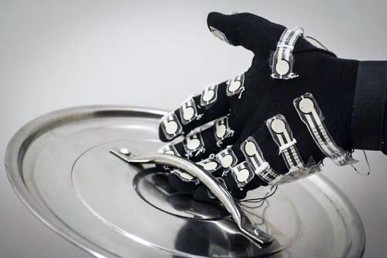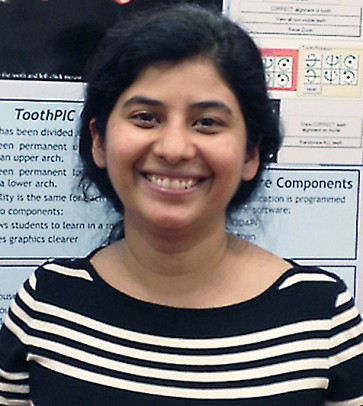Student’s research at the forefront of haptics

Doctoral student Maria Javaid uses a data glove covered in pressure sensors developed by the UIC Robotics Laboratory to study physical interactions between an older adult and caregiver.
When it comes to the growing field of haptics technology, Maria Javaid is at the forefront.
“There are few people who have realized that this should also be considered a mode of communication,” said Javaid, a doctoral candidate in electrical engineering. “So it is a very new field.”
Haptics uses a tactile feedback technology that sends force or vibrations back to the user — found in video games, cell phones and laptops.
It was Javaid’s research on haptics that brought her to WE13, the Annual Conference for Women Engineers that drew more than 6,000 women to Baltimore Oct. 24-26. She gave a presentation on the emerging field and her recent work on improving the lives of older adults through haptic technology.
“It was an introduction of my work,” she said. “So other colleagues would know what haptic technology is and may want to work on it.”
Javaid is using a data glove covered in pressure sensors developed by the UIC Robotics Laboratory to study physical interactions between an older adult and the caregiver, a RUSH nursing student.
The caregiver wears the glove when helping with everyday activities such as getting out of bed, moving around a studio apartment and preparing a meal. The glove records hand motions and delivers the data wirelessly to a computer.
The goal: to develop an interface that allows older adults to effectively communicate with a robotic assistant.
“If we want a robot to communicate with a human being, we first have to see how humans communicate through haptics,” Javaid said.
“Our work is kind of like the preliminary work in this area. So it’s not like we’ll solve the whole problem of how to understand communication through haptics — but we are starting that.”
Robotic assistance for seniors may seem distant today, but Javaid believes it’s just a matter of time.
“A few decades ago people didn’t think everyone would have iPads,” she said. “The elderly population is growing and there is a need to develop this technology.”
Javaid also educates College of Dentistry students on tooth anatomy, using 3-D simulation technology.
With a handheld device, students can control a dental tool onscreen and interact with a jaw in a 3-D virtual environment — like an interactive video game.
“Someone can grab a tooth in a 3-D environment — they can feel it and rotate it to see where it belongs in the gum,” she said. “That teaches them the right position and orientation of the tooth.”
Javaid completed her undergraduate and master’s degrees in electrical engineering at the University of Engineering and Technology at Lahore in Pakistan, where she was the first female lecturer in electrical engineering.
She joined UIC in fall 2008 and plans to finish her Ph.D. by summer 2014, she said.

